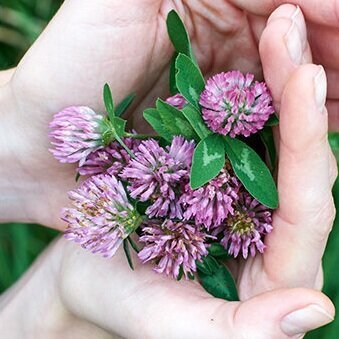Natural menopause relief for hot flushes
Red Clover as a natural menopause remedy for hot flushes
The onset of menopause has been described by some as the discovery that you have a ‘broken thermostat’, manifesting itself in uncontrollable hot flushes. Many women suffer in silence, help is at hand and the simplest way to find help is to first understand what is happening to your body.
Why am I getting hot flushes?
Oestrogen plays a vital role in maintaining a woman’s health and well-being over her lifetime. When women experience menopause, oestrogen levels start to decline, these lowered hormone levels are associated with a range of symptoms, including hot flushes, night sweats, sleep disturbance, anxiety, depression and mood swings. If oestrogens are so important to a woman’s health, why would nature purposely deprive the body of them?
Research suggests that the answers may lie in our diet. Nature didn’t get it wrong. Many of us in the west changed our diet away from the type of diet our ancestors ate – the same type of diet still typically eaten in Asian, Central American, and Mediterranean countries. A key factor in traditional Eastern diets is that they contain greater quantities of legumes, which are rich in a group of phytoestrogens (plant oestrogens) called isoflavones, renowned for helping to maintain hormonal balance.
Phytoestrogens as a natural alternative to HRT
Phytoestrogens are derived from naturally occurring isoflavones that have oestrogenic activity. They have a similar chemical structure to oestrogen and bind to the oestrogen receptors, acting like hormone regulators helping to balance see-sawing hormones in the run up to, during and after the menopause. This natural mode of action to mimic the body’s own natural oestrogen is why many recognise Phytoestrogens as the natural alternative to Hormone Replacement Therapy (HRT).
Studies have confirmed that diets rich in Phytoestrogens may help women experiencing the menopause, especially with symptoms such as hot flushes and night sweats*1. However, the typical European diet contains almost no isoflavones and you would need to consume a significant amount to obtain the recommended daily intake of 80mg*2. This is where supplementation of isoflavones may help. Most commonly, isoflavones are found in red clover (Trifolium pratense) and soy products. Red clover is one of the richest sources of natural isoflavones, containing twice as many types and in higher concentration than soya. Red clover isoflavones are also one of the most clinically researched isoflavones in the world in relation to studies specifically on menopausal women.
Why does red clover help menopause symptoms?
Most commonly, isoflavones are found in red clover (Trifolium pratense) and soy products. Red clover is one of the richest sources of natural isoflavones, containing twice as many types and in higher concentration than soya. Red clover isoflavones are also one of the most clinically researched isoflavones in the world in relation to studies specifically on menopausal women.
Find more natural ways to relieve hot flushes and night sweats here.
*1 Chen MN, Lin CC, & Liu CF (2015): Efficacy of phytoestrogens for menopausal symptoms: a meta-analysis and systematic review. Climacteric 18:260-269
*2 Source: Van Erp-Baart et al., 2003



